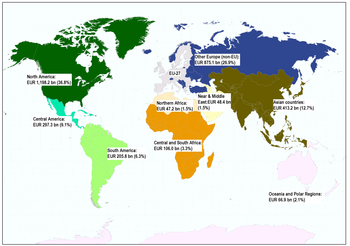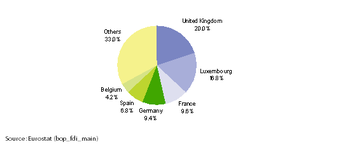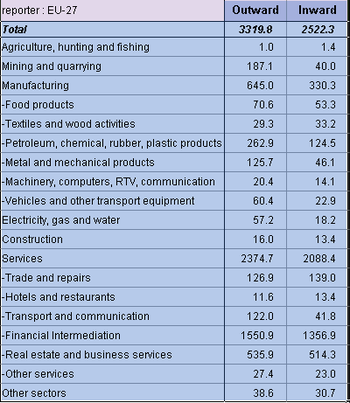Archive:Foreign direct investment statistics
- Data from October 2010, most recent data: Further Eurostat information, Main tables and Database.
Foreign direct investment (FDI) is the category of international investment made by an entity resident in one economy (direct investor) to acquire a lasting interest in an enterprise operating in another economy (direct investment enterprise). The lasting interest is deemed to exist if the direct investor acquires at least 10 % of the voting power of the direct investment enterprise. FDI is a component of the balance of payments showing all financial transactions between one country or area – such as the European Union (EU) – and all other countries. This article discusses the developments for FDI in the EU, examining inward and outward flows, the origin and destination of these flows, important investment activities, as well as stocks of FDI at the end of the year.
Main statistical findings
File:FDI outward flows by main partner, 2009 (1) (EUR 1 000 million).png
Effects of the financial and economic crisis
Flows of FDI (new investments made during the reference period) fluctuate considerably from one year to the next, partly as a function of economic fortunes. FDI flows generally increase during times of rapid economic growth, while disinvestment is more likely during periods of recession as businesses focus on core activities in their domestic market.
FDI flows from the EU-27 to countries outside of the EU (extra-EU) reached a record level in 2007 (EUR 530 738 million), mainly as a result of major cross-border mergers and acquisitions and reinvestment of earnings. However, the EU-27’s FDI flows were severely affected by the global financial and economic crisis. In 2008, reinvested earnings paid to extra-EU investors dropped by 50 % and these continued to decline in 2009. Equity capital, mainly mergers and acquisitions activity, showed a similar trend dropping by one third in 2008 and continuing to fall in 2009. As a result, total EU-27 outward FDI flows fell 34 % in 2008 and by a further 24 % in 2009, down to EUR 263 335 million (see Table 3).
Inward flows of FDI to the EU-27 (from other non-member countries) also peaked in 2007 and fell even more sharply than outward flows in 2008, down 52 %. However, inward flows returned to an upward path in 2009, increasing by 12 % to reach EUR 221 734 million.
Being influenced by particularly large mergers and acquisitions, FDI flows can fluctuate considerably from one year to another – although the main players among EU Member States generally remain the same from one year to the next. The latest data for 2009 is presented in Tables 1 and 2).
Foreign direct investment by partner
FDI flows between developed economies were the first to be affected by the financial and economic crisis. The United States was the leading investment partner for the EU-27 in 2007 (EUR 183 547 million), and the drop in incoming FDI flows was significant in 2008, as FDI inward flows from the United States to the EU-27 fell to EUR 50 458 million. However, preliminary data for 2009 shows that there was at least a partial recovery 2009 as flows of FDI from the United States to the EU-27 almost doubled with respect to 2008 to reach EUR 96 847 million. EU-27 outward investment flows to the United States saw a more moderate rate of decline in 2008 (from EUR 168 891 million to EUR 121 442 million), and this pattern continued in 2009, as outflows to the United States were valued at EUR 68 991 million.
EU-27 investments in many emerging economies continued to surge in 2008. The steady growth in EU-27 investment flows to Russia peaked in 2008 (EUR 25 561 million), although there was a sharp downturn in 2009 as a result of disinvestment. EU-27 investments to Africa also recorded growth in 2008, mainly due to a significant amount of FDI outflows to Egypt (EUR 9 808 million), which largely originated from French businesses. Total investment in Asia also continued to grow in 2008. However, EU-27 outflows to Japan fell by 43 % in 2008, and this pattern continued in 2009, such that EU-27 investments to Japan were worth EUR 126 million. There was a relatively minor degree of fluctuation in FDI outflows to China and India. Preliminary figures for 2009 show a slight increase in outflows to China (from EUR 4 734 million to EUR 5 290 million).
In 2008, inflows of FDI from outside the EU-27 were worth less than half of what they had been a year before. The drop would have been even more significant without a major inflow from Arabian Gulf countries to Luxembourg.
Average outward flows of FDI during the period 2006 to 2008 show that the United Kingdom was the main investor in countries outside the EU, followed by Luxembourg (see Figure 2). The main investment partners of the United Kingdom were the United States and Canada, followed by Australia and Switzerland. After peaking in 2007, the United Kingdom recorded a drastic drop in outflows of FDI to all of these partner countries, except Australia. Luxembourg's high share may be explained by the activities of special purpose entities (SPEs). In some other EU-27 Member States, especially the Netherlands and Hungary, SPEs likewise play an important role. However, the national data for these countries presented in this article exclude SPEs. The fact that Luxembourg’s main partners are the United States, Switzerland and offshore financial centres shows how important the financial sector is in Luxembourg.
Change in foreign direct investment positions (stocks)
The annual growth rate of both EU-27 outward and inward positions (stocks) slowed down in 2008 compared with the previous three years. In 2007, annual growth in outward stocks was 13.2 % and in inward positions 16.0 %, whereas in 2008 FDI outward and inward stocks increased only by 4.7 % and 3.2 % respectively (see Table 4).
One third (EUR 1 058 052 million) of total EU outward positions of FDI were held in the United States at the end of 2008. EU-27 stocks of FDI held in the United States were mainly concentrated in the service sector (69.0 % at the end of 2007), in particular in financial intermediation and business activities. In the manufacturing sector, the main stock of EU-27 FDI was concentrated within the manufacture of chemicals and chemical products in the United States. At the end of 2008, the United Kingdom was the main holder of FDI stocks in the United States, with 23.8 % of the EU-27 total (EUR 251 624 million).
Switzerland was the second most important destination of EU stocks (13.9 % of extra-EU stocks at the end of 2008), financial intermediation being the main activity sector. EU-27 stocks held in Russia have been growing significantly in recent years, up to EUR 91 955 million at the end of 2008. The service sector accounted for 55.3 % of all EU-27 stocks held in Russia (at the end of 2007), but there was major investment in the extraction of petroleum and gas. Among the Asian countries, the main EU-27 positions were in Singapore, Hong Kong and Japan. The fastest growth in the region was recorded for China and India, but these countries did not feature in the top ten main investment destinations, with stocks of EUR 47 285 million and EUR 19 362 million respectively in 2008.
The United States had the major share of the EU-27 inward positions (43 % and EUR 1 046 157 million at the end of 2008). The service sector was the major investment activity for the United States in the EU, covering almost 80 % of total inward investments from the United States at the end of 2007. The stock held in the EU-27 by Switzerland at the end of 2008 was EUR 306 199 million, which was slightly less than at the end of 2007. Japan's stocks of FDI invested in the EU-27 declined to EUR 116 927 million at the end of 2008, and the stock held by Canada remained stable at EUR 105 054 million. Finally, Brazil almost tripled its stocks in the EU-27 during the period 2006 to 2008.
Foreign direct investment by activity
The structure of EU-27 FDI stocks by activity is shown in Table 5. Services represented the biggest share (70 %) of the EU-27’s total positions abroad in 2007. More than half of the stocks in services were concentrated within financial intermediation, which registered an annual increase of 18.6 % between the end of 2006 and the end of 2007.
For inward positions, services accounted for the highest share of stocks held in the EU-27 at the end of 2007 (80.4 % of the total), with financial intermediation again contributing the largest share. Among the sectors presented in Table 5, the EU-27’s stocks of FDI vis-à-vis the rest of the world in 2007 only reported a deficit for textile and wood manufacturing, trade and repairs, and real estate and business services.
Income and rates of return
The financial and economic crisis also reduced income from investments abroad. EU-27 investment income dropped sharply in 2008 to EUR 195 915 million from a record high of EUR 261 390 million in 2007 (see Figure 3). In particular, income received from EU-27 investments in the United States declined from EUR 70 465 million in 2007 to EUR 36 743 million in 2008. EU-27 income paid to extra-EU investors recorded a modest decline of 7.5 % in 2008, to EUR 126 274 million.
Data sources and methodology
FDI statistics in the EU are collected according to Regulation (EC) No 184/2005 of the European Parliament and of the Council on Community statistics concerning balance of payments, international trade in services and foreign direct investment.
The methodological framework used is that of the OECD’s benchmark definition of foreign direct investment third edition, a detailed operational definition fully consistent with the IMF balance of payments manual, fifth edition.
Annual EU foreign direct investment statistics give a detailed presentation of FDI flows and stocks, showing which Member States invest in which partner countries and in which sectors. Eurostat collects FDI statistics for quarterly and annual flows, as well as for stocks at the end of the year. FDI stocks (assets and liabilities) are part of the international investment position of an economy at the end of the year.
Through outward FDI flows, an investor country builds up FDI assets abroad (outward FDI stocks). Correspondingly, inward FDI flows cumulate into liabilities towards foreign investors (inward FDI stocks). However, changes in FDI stocks differ from FDI flows because of the impact of revaluation (changes in prices and, for outward stocks, exchange rates) and other adjustments such as catastrophic losses, cancellation of loans, reclassification of existing assets or liabilities.
FDI flows are components of the financial account of the balance of payments, while FDI assets and liabilities are components of the international investment position. FDI income consists of the income accruing to the direct investor from its affiliates abroad. Income earned from outward FDI is recorded among credits in the current account of the balance of payments, while income paid to foreign owners of inward FDI stocks is recorded among debits.
FDI flows and positions are recorded according to the immediate host/investing country criterion. The economic activity for both flows abroad and flows in the reporting economy are classified according to the economic activity of the resident enterprise; the same applies to FDI positions.
FDI flows are new investments made during the reference period, whereas FDI stocks provide information on the position, in terms of value, of all previous investments at the end of the reference period. The intensity of FDI can be measured by averaging the value of inward and outward flows during a particular reference period and expressing this in relation to GDP.
The sign convention adopted for the data shown in this article, for both flows and stocks, is that investment is always recorded with a positive sign, and a disinvestment with a negative sign.
European aggregates (such as EU-27) include special purpose entities (SPEs), which are a particular class of enterprises (often empty shells or holding companies) not included in all countries' national statistics. Therefore, these aggregates are not simply the addition of national figures.
Context
In a world of increasing globalisation, where political, economic and technological barriers are rapidly disappearing, the ability of a country to participate in global activity is an important indicator of its performance and competitiveness.
In order to remain competitive, modern-day business relationships extend well beyond the traditional foreign exchange of goods and services, as witnessed by the increasing reliance of enterprises on mergers, partnerships, joint ventures, licensing agreements, and other forms of business co-operation.
FDI may be seen as an alternative economic strategy, adopted by those enterprises that invest to establish a new plant/office, or alternatively, purchase existing assets of a foreign enterprise. These enterprises seek to complement or substitute external trade, by producing (and often selling) goods and services in countries other than where the enterprise was first established.
There are two kinds of FDI, namely the creation of productive assets by foreigners or the purchase of existing assets by foreigners (acquisitions, mergers, takeovers, etc.). FDI differs from portfolio investments because it is made with the purpose of having control or an effective voice in management and a lasting interest in the enterprise. Direct investment not only includes the initial acquisition of equity capital, but also subsequent capital transactions between the foreign investor and domestic and affiliated enterprises.
Conventional trade is less important for services than for goods. While trade in services has been growing, the share of services in total intra-EU trade has changed little during the last decade. However, FDI is expanding more rapidly for services than for goods, increasing at a more rapid pace than conventional trade in services. As a result, the share of services in total FDI flows and positions has increased substantially, with services within the EU-27 becoming increasingly international.
Further Eurostat information
Publications
Main tables
- European Union direct investments (t_bop_fdi)
Database
- European Union direct investments (bop_fdi)
Methodology/Metadata
- European Union direct investments [ESMS metadata file - bop_fdi_esms]
Other information
Source data for tables, figures and map (MS Excel)
External links
- OECD Benchmark Definition of Foreign Direct Investment
- United Nations Conference on Trade and Development (UNCTAD) - FDI Statistics







